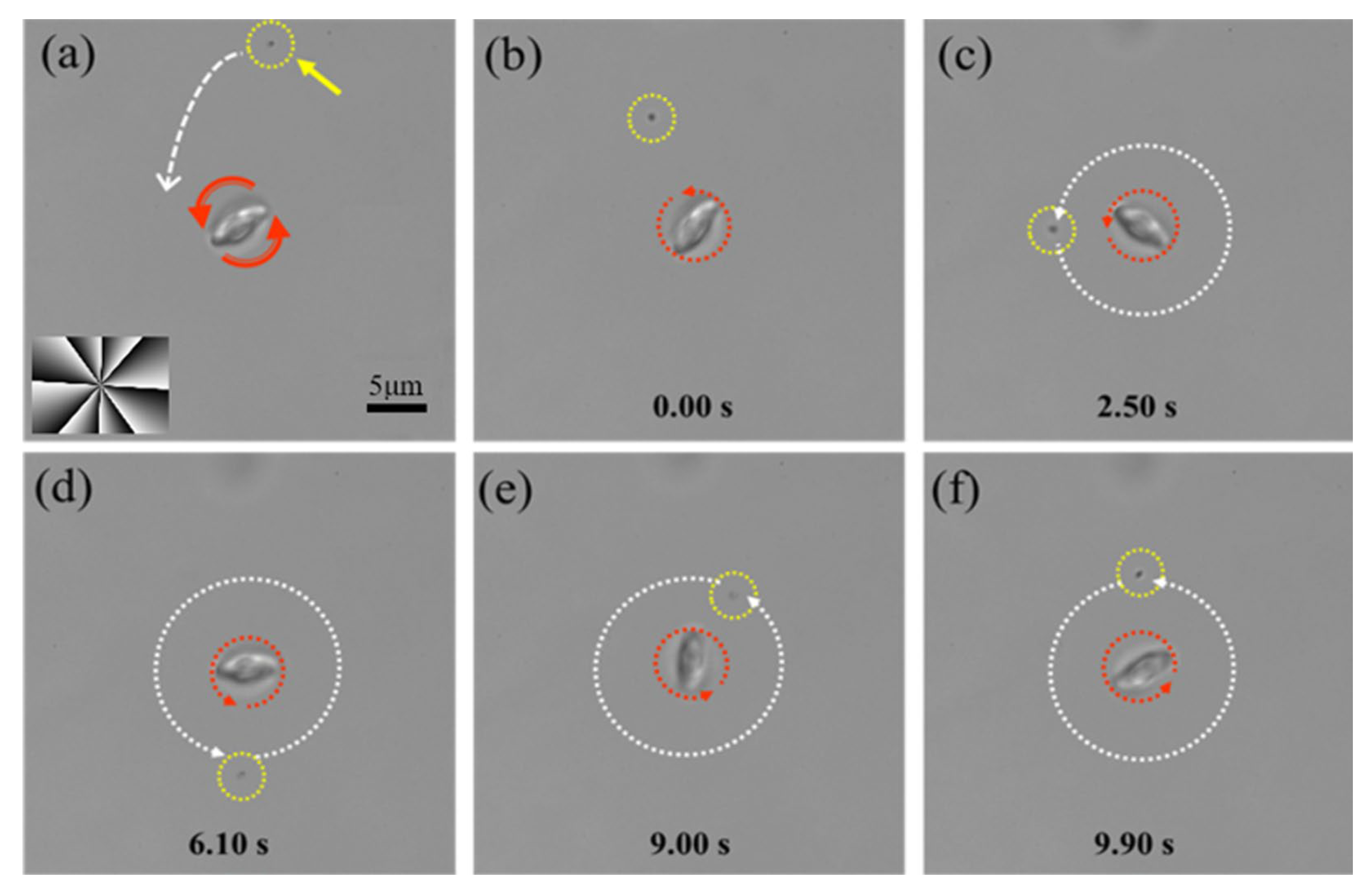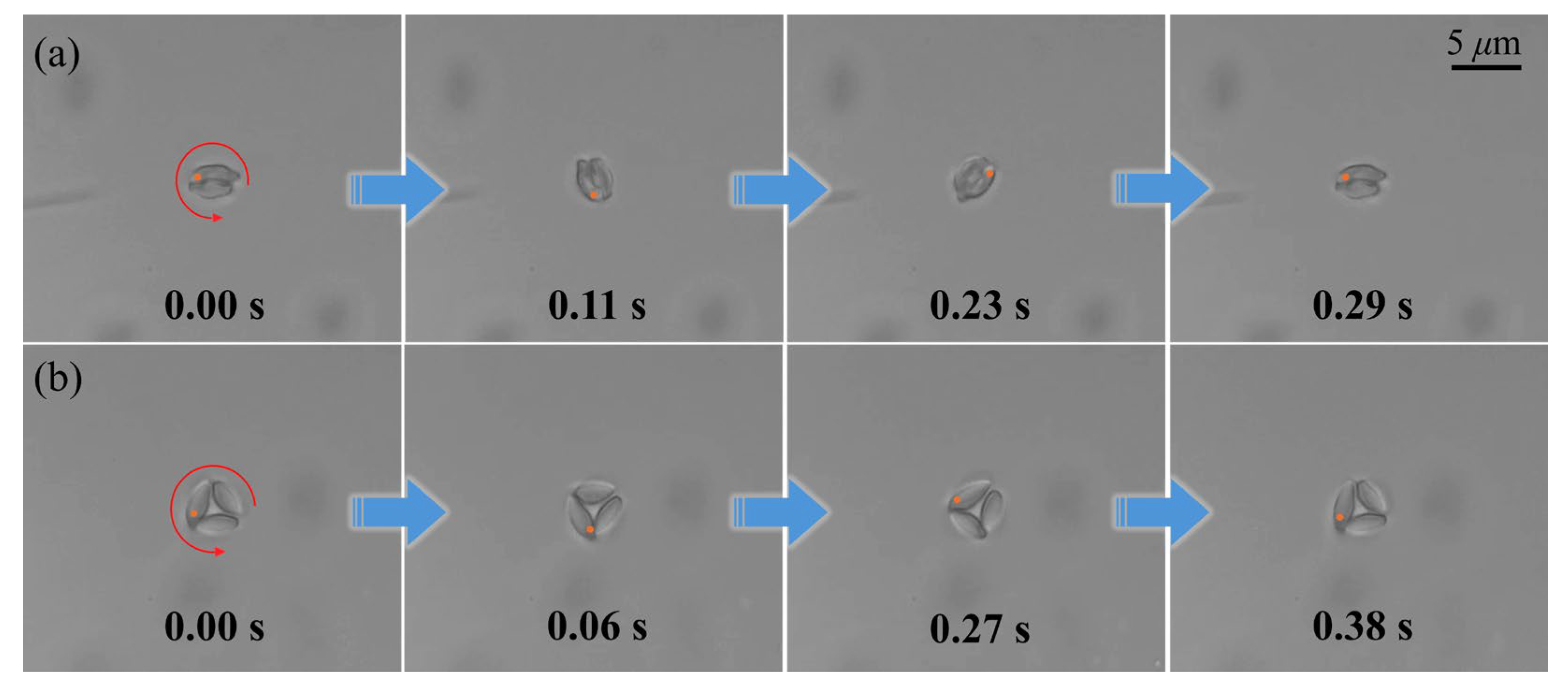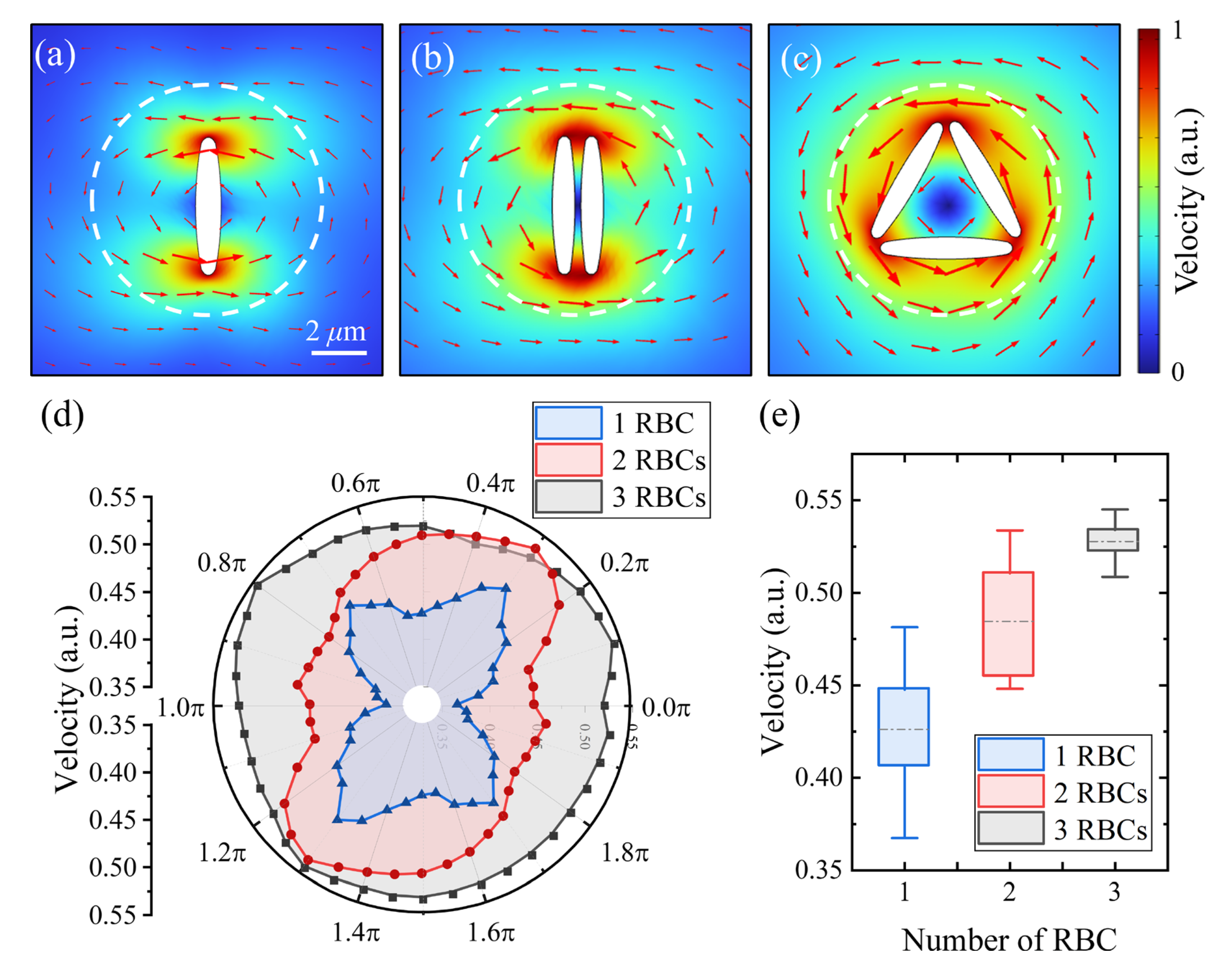Red Blood Cell-Based Biological Micromotors Propelled by Spiral Optical Fields
Abstract
1. Introduction
2. Methods
2.1. Design Principles and Theoretical Simulation
2.2. Experimental Setup
2.3. Image Analysis and Particle Tracking
2.4. Zebrafish Handling and In Vivo Imaging
3. Results
3.1. Interaction Between the Spiral Light Field and PS Microspheres
3.2. Validation of RBC Micromotors and Their Collection and Cleaning of Particles
3.3. Construction of Multi-RBC Micromotors and In Vivo Implementation in Zebrafish
4. Discussion
Supplementary Materials
Author Contributions
Funding
Institutional Review Board Statement
Informed Consent Statement
Data Availability Statement
Conflicts of Interest
Abbreviations
| OTs | optical tweezers |
| RBC | red blood cell |
| SOTs | scanning optical tweezers |
| PS | polystyrene |
| LG | Laguerre–Gaussian |
| OAM | orbital angular momentum |
| SLMs | spatial light modulators |
| NA | numerical aperture |
References
- Ou, J.; Liu, K.; Jiang, J.; Wilson, D.A.; Liu, L.; Wang, F.; Wang, S.; Tu, Y.; Peng, F. Micro-/nanomotors toward biomedical applications: The recent progress in biocompatibility. Small 2020, 16, 1906184. [Google Scholar] [CrossRef] [PubMed]
- Liu, S.; Gao, C.; Peng, F. Micro/nanomotors in regenerative medicine. Mater. Today Adv. 2022, 16, 100281. [Google Scholar] [CrossRef]
- Srivastava, S.K.; Clergeaud, G.; Andresen, T.L.; Boisen, A. Micromotors for drug delivery in vivo: The road ahead. Adv. Drug Deliv. Rev. 2019, 138, 41–55. [Google Scholar] [CrossRef] [PubMed]
- Esteban-Fernández de Ávila, B.; Gao, W.; Karshalev, E.; Zhang, L.; Wang, J. Cell-like micromotors. Acc. Chem. Res. 2018, 51, 1901–1910. [Google Scholar] [CrossRef]
- Rojas, D.; Jurado-Sánchez, B.; Escarpa, A. “Shoot and sense” Janus micromotors-based strategy for the simultaneous degradation and detection of persistent organic pollutants in food and biological samples. Anal. Chem. 2016, 88, 4153–4160. [Google Scholar] [CrossRef]
- Mehregany, M.; Tai, Y.-C. Surface micromachined mechanisms and micromotors. J. Micromech. Microeng. 1991, 1, 73. [Google Scholar] [CrossRef]
- Barbade, D.; Soni, R.; Metan, S. Micromotor Fabrication by Surface Micromachining Technique. In MEMS and Nanotechnology, Proceedings of the 2010 Annual Conference on Experimental and Applied Mechanics, Indianapolis, IN, USA, 7–10 June 2010; Springer: New York, NY, USA, 2011; Volume 2, pp. 139–146. [Google Scholar]
- Wan, M.; Li, T.; Chen, H.; Mao, C.; Shen, J. Biosafety, functionalities, and applications of biomedical micro/nanomotors. Angew. Chem. Int. Ed. 2021, 60, 13158–13176. [Google Scholar] [CrossRef]
- Gardi, G.; Ceron, S.; Wang, W.; Petersen, K.; Sitti, M. Microrobot collectives with reconfigurable morphologies, behaviors, and functions. Nat. Commun. 2022, 13, 2239. [Google Scholar] [CrossRef]
- Zou, X.; Zheng, Q.; Wu, D.; Lei, H. Controllable Cellular Micromotors Based on Optical Tweezers. Adv. Funct. Mater. 2020, 30, 2002081. [Google Scholar] [CrossRef]
- Li, Y.; Liu, X.; Xu, X.; Xin, H.; Zhang, Y.; Li, B. Red-blood-cell waveguide as a living biosensor and micromotor. Adv. Funct. Mater. 2019, 29, 1905568. [Google Scholar] [CrossRef]
- Wu, T.; Nieminen, T.A.; Mohanty, S.; Miotke, J.; Meyer, R.L.; Rubinsztein-Dunlop, H.; Berns, M.W. A photon-driven micromotor can direct nerve fibre growth. Nat. Photonics 2012, 6, 62–67. [Google Scholar] [CrossRef]
- Feng, Y.; Gao, C.; Xie, D.; Liu, L.; Chen, B.; Liu, S.; Yang, H.; Gao, Z.; Wilson, D.A.; Tu, Y. Directed Neural Stem Cells Differentiation via Signal Communication with Ni–Zn Micromotors. Adv. Mater. 2023, 35, 2301736. [Google Scholar] [CrossRef]
- Simaan, N.; Yasin, R.M.; Wang, L. Medical technologies and challenges of robot-assisted minimally invasive intervention and diagnostics. Annu. Rev. Control Robot. Auton. Syst. 2018, 1, 465–490. [Google Scholar] [CrossRef]
- Cao, H.X.; Jung, D.; Lee, H.-S.; Go, G.; Nan, M.; Choi, E.; Kim, C.-S.; Park, J.-O.; Kang, B. Micromotor manipulation using ultrasonic active traveling waves. Micromachines 2021, 12, 192. [Google Scholar] [CrossRef]
- Gao, Q.; Yang, Z.; Zhu, R.; Wang, J.; Xu, P.; Liu, J.; Chen, X.; Yan, Z.; Peng, Y.; Wang, Y. Ultrasonic steering wheels: Turning micromotors by localized acoustic microstreaming. ACS Nano 2023, 17, 4729–4739. [Google Scholar] [CrossRef]
- Wu, Z.; Li, T.; Li, J.; Gao, W.; Xu, T.; Christianson, C.; Gao, W.; Galarnyk, M.; He, Q.; Zhang, L. Turning erythrocytes into functional micromotors. Acs Nano 2014, 8, 12041–12048. [Google Scholar] [CrossRef]
- Hou, K.; Zhang, Y.; Bao, M.; Xin, C.; Wei, Z.; Lin, G.; Wang, Z. A multifunctional magnetic red blood cell-mimetic micromotor for drug delivery and image-guided therapy. ACS Appl. Mater. Interfaces 2022, 14, 3825–3837. [Google Scholar] [CrossRef]
- Būtaitė, U.G.; Gibson, G.M.; Ho, Y.-L.D.; Taverne, M.; Taylor, J.M.; Phillips, D.B. Indirect optical trapping using light driven micro-rotors for reconfigurable hydrodynamic manipulation. Nat. Commun. 2019, 10, 1215. [Google Scholar] [CrossRef]
- Metzger, N.; Mazilu, M.; Kelemen, L.; Ormos, P.; Dholakia, K. Observation and simulation of an optically driven micromotor. J. Opt. 2011, 13, 044018. [Google Scholar] [CrossRef]
- Li, J.; Esteban-Fernández de Ávila, B.; Gao, W.; Zhang, L.; Wang, J. Micro/nanorobots for biomedicine: Delivery, surgery, sensing, and detoxification. Sci. Robot. 2017, 2, eaam6431. [Google Scholar] [CrossRef]
- Wu, R.; Zhu, Y.; Cai, X.; Wu, S.; Xu, L.; Yu, T. Recent process in microrobots: From propulsion to swarming for biomedical applications. Micromachines 2022, 13, 1473. [Google Scholar] [CrossRef] [PubMed]
- Ashkin, A.; Dziedzic, J.M.; Bjorkholm, J.E.; Chu, S. Observation of a single-beam gradient force optical trap for dielectric particles. Opt. Lett. 1986, 11, 288–290. [Google Scholar] [CrossRef] [PubMed]
- Qu, Z.; Wang, K.; Feng, C.; Wu, T.; Zhang, Y.; Zhao, X.; Wang, J.-L. Optofluidic sorting of microparticles using Airy beams. Int. J. Optomechatronics 2024, 18, 2375538. [Google Scholar] [CrossRef]
- Liu, X.; Wu, H.; Wu, S.; Qin, H.; Zhang, T.; Lin, Y.; Zheng, X.; Li, B. Optically Programmable Living Microrouter in Vivo. Adv. Sci. 2023, 10, 2304103. [Google Scholar] [CrossRef]
- Liu, X.; Gao, Q.; Wu, S.; Qin, H.; Zhang, T.; Zheng, X.; Li, B. Optically Manipulated Neutrophils as Native Microcrafts In Vivo. ACS Cent. Sci. 2022, 8, 1017–1027. [Google Scholar] [CrossRef]
- Gao, Q.; Wang, W.; Li, X.; Li, Y.; Ferraro, P.; Jiao, X.; Liu, X.; Zhang, Y.; Li, B. Cell nucleus as endogenous biological micropump. Biosens. Bioelectron. 2021, 182, 113166. [Google Scholar] [CrossRef]
- Xu, X.; Yang, Y.; Chen, L.; Chen, X.; Wu, T.; Li, Y.; Liu, X.; Zhang, Y.; Li, B. Optomechanical wagon-wheel effects for bidirectional sorting of dielectric nanoparticles. Laser Photonics Rev. 2021, 15, 2000546. [Google Scholar] [CrossRef]
- Zhou, Y.; Li, S.; Gao, J.; Qin, Y.; Zhang, Y.; Zhang, Y.; Liu, Z.; Yuan, L. All-fiber rotary micromotor based on laser-induced thermal convection. Opt. Laser Technol. 2023, 165, 109639. [Google Scholar] [CrossRef]
- Zhang, Y.; Lin, S.; Liu, Z.; Zhang, Y.; Zhang, J.; Yang, J.; Yuan, L. Laser-induced rotary micromotor with high energy conversion efficiency. Photon. Res. 2020, 8, 534–538. [Google Scholar] [CrossRef]
- Courtial, J.; Padgett, M.J. Limit to the orbital angular momentum per unit energy in a light beam that can be focussed onto a small particle. Opt. Commun. 2000, 173, 269–274. [Google Scholar] [CrossRef]
- Li, X.; Dan, D.; Yu, X.; Zhou, Y.; Zhang, Y.; Gao, W.; Li, M.; Xu, X.; Yan, S.; Yao, B. Concentric ring optical traps for orbital rotation of particles. Nanophotonics 2023, 12, 4507–4517. [Google Scholar] [CrossRef] [PubMed]
- Zhu, L.; Tang, M.; Li, H.; Tai, Y.; Li, X. Optical vortex lattice: An exploitation of orbital angular momentum. Nanophotonics 2021, 10, 2487–2496. [Google Scholar] [CrossRef]
- Wu, L.; Bai, Z.; Wang, Y.; Liu, R.; Yu, J.; Ran, J.; Luo, Z.; Liu, S.; Wang, Y.; Chen, G.Y.; et al. Micromotor based on single fiber optical vortex tweezer. APL Photonics 2024, 9, 116106. [Google Scholar] [CrossRef]
- Nguyen, H.T.; Stepniewski, G.; Filipkowski, A.; Kasztelanic, R.; Pysz, D.; Le Van, H.; Stepien, R.; Klimczak, M.; Krolikowski, W.; Buczynski, R. Transmission of an optical vortex beam in antiresonant fibers generated in an all-fiber system. Opt. Express 2022, 30, 45635–45647. [Google Scholar] [CrossRef]
- Liu, S.; Fan, X.; Qu, Z.; Fang, C.; Feng, C.; Zhao, X.; Wang, J.-L. Improving the multi-functionality of optical tweezers with FPGA integration. Appl. Opt. 2023, 63, 255–262. [Google Scholar] [CrossRef]
- Yao, A.M.; Padgett, M.J. Orbital angular momentum: Origins, behavior and applications. Adv. Opt. Photon. 2011, 3, 161–204. [Google Scholar] [CrossRef]
- Curtis, J.E.; Grier, D.G. Structure of optical vortices. Phys. Rev. Lett. 2003, 90, 133901. [Google Scholar] [CrossRef]
- Qu, Z.; Liu, S.; Fan, X.; Fang, C.; Wang, J.-L.; Zhao, X. Optimized hologram generation method for real-time spontaneous manipulation. AIP Adv. 2023, 13, 095216. [Google Scholar] [CrossRef]
- Jones, P.H.; Maragò, O.M.; Volpe, G. Optical Tweezers: Principles and Applications; Cambridge University Press: Cambridge, UK, 2016. [Google Scholar]
- Liu, S.; Qu, Z.; Zhao, X.; Wang, J.-L. Fast and versatile optical force measurement with digitally modulated stimulus in holographic optical tweezers. Opt. Laser Technol. 2023, 167, 109809. [Google Scholar] [CrossRef]
- Koekoek, R. Generalizations of Laguerre polynomials. J. Math. Anal. Appl. 1990, 153, 576–590. [Google Scholar] [CrossRef]
- Izakian, Z.; Mesgari, M.S.; Weibel, R. A feature extraction based trajectory segmentation approach based on multiple movement parameters. Eng. Appl. Artif. Intell. 2020, 88, 103394. [Google Scholar] [CrossRef]
- Hsieh, J.-W.; Yu, S.-L.; Chen, Y.-S. Motion-based video retrieval by trajectory matching. IEEE Trans. Circuits Syst. Video Technol. 2006, 16, 396–409. [Google Scholar] [CrossRef]
- Ma, G.; Yue, X. An improved whale optimization algorithm based on multilevel threshold image segmentation using the Otsu method. Eng. Appl. Artif. Intell. 2022, 113, 104960. [Google Scholar] [CrossRef]
- Krasnikov, I.; Seteikin, A.; Bernhardt, I. Thermal processes in red blood cells exposed to infrared laser tweezers (λ = 1064 nm). J. Biophotonics 2011, 4, 206–212. [Google Scholar] [CrossRef]
- de Oliveira, M.A.; Moura, D.; Fontes, A.; de Araujo, R. Damage induced in red blood cells by infrared optical trapping: An evaluation based on elasticity measurements. J. Biomed. Opt. 2016, 21, 075012. [Google Scholar] [CrossRef]







Disclaimer/Publisher’s Note: The statements, opinions and data contained in all publications are solely those of the individual author(s) and contributor(s) and not of MDPI and/or the editor(s). MDPI and/or the editor(s) disclaim responsibility for any injury to people or property resulting from any ideas, methods, instructions or products referred to in the content. |
© 2025 by the authors. Licensee MDPI, Basel, Switzerland. This article is an open access article distributed under the terms and conditions of the Creative Commons Attribution (CC BY) license (https://creativecommons.org/licenses/by/4.0/).
Share and Cite
Wang, K.; Qu, Z.; Chen, Y.; Wu, T.; Feng, C.; Zhang, J.; Zhao, X.; Wang, J.-L. Red Blood Cell-Based Biological Micromotors Propelled by Spiral Optical Fields. Photonics 2025, 12, 531. https://doi.org/10.3390/photonics12060531
Wang K, Qu Z, Chen Y, Wu T, Feng C, Zhang J, Zhao X, Wang J-L. Red Blood Cell-Based Biological Micromotors Propelled by Spiral Optical Fields. Photonics. 2025; 12(6):531. https://doi.org/10.3390/photonics12060531
Chicago/Turabian StyleWang, Kunpeng, Zhelin Qu, Yifei Chen, Tianli Wu, Chao Feng, Jian Zhang, Xian Zhao, and Jun-Lei Wang. 2025. "Red Blood Cell-Based Biological Micromotors Propelled by Spiral Optical Fields" Photonics 12, no. 6: 531. https://doi.org/10.3390/photonics12060531
APA StyleWang, K., Qu, Z., Chen, Y., Wu, T., Feng, C., Zhang, J., Zhao, X., & Wang, J.-L. (2025). Red Blood Cell-Based Biological Micromotors Propelled by Spiral Optical Fields. Photonics, 12(6), 531. https://doi.org/10.3390/photonics12060531






